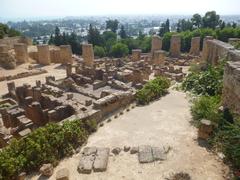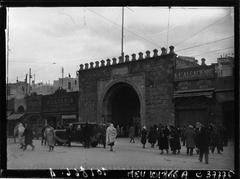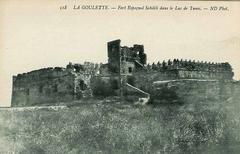
Bab Saadoun Visiting Hours, Tickets, and Guide to Tunis Historical Sites
Date: 04/07/2025
Introduction
Bab Saadoun, one of the most iconic gates of the Medina of Tunis, stands as a remarkable symbol of Tunisia’s rich historical, architectural, and spiritual heritage. Erected around 1350 CE during the Hafsid dynasty, this historic monument has served as a crucial defensive entryway to the city, controlling access to important northwestern trade and travel routes (Tunisie.co; Tripomatic). Named after the local saint Sidi Bou Saadoun, it represents the harmonious intersection of spiritual reverence and civic significance in North African Islamic urbanism.
Bab Saadoun evolved from a medieval single-arch gate to its current three-arched form in 1881, reflecting the city’s growth and modernization (World Travel Guide; Mubawab). Today, it remains a vibrant public landmark, accessible around the clock and surrounded by bustling markets, mosques, and museums. This guide offers detailed information on visiting Bab Saadoun—covering its historical background, architectural features, practical travel tips, and nearby attractions—helping you make the most of your visit to Tunis’s dynamic heart (La Presse; Archiqoo).
Location and Access
Bab Saadoun is located on the northwestern edge of the Medina of Tunis, at a busy roundabout that connects major roads leading towards Béja, Bizerte, El Kef, the Bardo, and other key districts (La Presse; Wikipedia). Its historical role as a gateway to the northwest remains evident in the urban fabric of contemporary Tunis.
How to Get There
- Public Transport: Multiple city bus lines and the Tunis light rail (tramway) serve the Bab Saadoun area. The tramway historically passed through the central arch, a fact still visible in old postcards (La Presse).
- Taxi: Taxis and ride-hailing apps are widely available; Bab Saadoun is a common destination due to its centrality.
- Louage (Shared Minibus): The main louage station is nearby, providing affordable intercity travel (Nicki Posts Travel Stuff).
- Walking: The medina is highly walkable. Bab Saadoun is approximately 20–25 minutes on foot from other major gates like Bab el Bhar and Place de la Kasbah (Trek Zone).
History and Architectural Evolution
Origins and Construction
Constructed around 1350 CE during the Hafsid period, Bab Saadoun was initially a single-arch gate designed for defensive purposes. Its strategic location managed entry to the Bab Souika suburb, a vibrant commercial and residential area (Tunisie.co).
Expansion and Modernization
In 1881, the gate was rebuilt with three arches to accommodate increased commercial and pedestrian traffic, marking the city’s transition into a modern urban center (World Travel Guide). The expansion mirrored similar modifications at other historic gates, such as Bab El Khadra and Bab El Fellah, reflecting broader patterns of urban growth and connectivity.
Architectural Features
- Three-Arched Structure: The central arch is broad enough for vehicular passage, while flanking arches serve pedestrians and smaller carts (Wikipedia).
- Islamic and Maghrebi Elements: Horseshoe arches, geometric stonework, and minimal ornamentation emphasize functionality yet echo traditional design (Archiqoo).
- Layered Influences: Ottoman domes, Andalusian garden elements, and colonial-era infrastructure surround the gate, reflecting centuries of urban transformation.
Spiritual and Cultural Significance
Named after Sidi Bou Saadoun, the gate carries spiritual resonance, believed to offer protection and blessings to the city’s inhabitants (La Presse). Its role has extended beyond defense, serving as a gathering point for markets, religious processions, and civic events (Webdo.tn).
Visiting Bab Saadoun: Practical Information
Visiting Hours
Bab Saadoun is an open public monument with unrestricted access, 24 hours a day, seven days a week. For safety and to best appreciate its details, plan your visit during daylight hours.
Tickets and Entrance Fee
No tickets or entrance fees are needed; the gate and its immediate surroundings are freely accessible to all.
Accessibility
- Mobility: The area is paved and generally accessible, but some adjacent medina streets are narrow or uneven. Comfortable shoes are recommended.
- Transport: Easily reached by bus, tramway, taxi, or louage. The nearby roundabout can be busy, so exercise caution when crossing streets.
Nearby Visitor Amenities
- Cafés and Restaurants: Numerous dining options are available within a short walk, offering traditional Tunisian cuisine.
- Shops and Souks: The surrounding souks are ideal for purchasing crafts, textiles, and souvenirs.
- Accommodation: Choose from guesthouses within the medina or hotels in the Ville Nouvelle.
What to See & Do Around Bab Saadoun
Key Sights Within Walking Distance
- Souk Sidi Sridek: Traditional market, ~22 minutes away (Trek Zone).
- Dar Ben Achour: Historic mansion and cultural center, ~18 minutes away.
- Khaznadar Palace: Architectural gem, ~13 minutes on foot.
- Tabbanine (Sidi Jaafar) Mosque: Historic mosque, ~8 minutes from the gate.
- Souk El Beransia: Marketplace for traditional crafts, ~25 minutes away.
Photography Tips
Bab Saadoun’s three arches and the lively urban roundabout make for compelling photography, especially at sunrise or sunset when the light accentuates the stonework.
Travel Tips
- Climate: Visit in spring (March–May) or autumn (September–November) for the most comfortable weather (Travellerspoint).
- Safety: Keep an eye on personal belongings in busy areas and be mindful of traffic.
- Language: Arabic and French are widely spoken; English is less common but understood in tourist contexts.
- Facilities: No dedicated visitor facilities at the gate, but amenities are available in the surrounding area.
Transportation Guide
- Louage (Shared Minibus): The main intercity louage station is nearby. Louages are affordable and depart frequently (Nicki Posts Travel Stuff).
- Taxis/Ride-Hailing: Plentiful and metered; ride-hailing apps such as Bolt operate in Tunis.
- Tramway & Buses: Efficient for reaching other parts of Tunis, with stops close to Bab Saadoun.
Cultural Etiquette
- Photography: Permitted at Bab Saadoun, but always ask before photographing people, especially near religious sites.
- Respect: Climbing on the monument or causing damage is strictly forbidden.
- Dress Code: Modest attire is recommended when exploring the medina and religious buildings.
Events and Local Life
While Bab Saadoun itself is not the focus of major festivals, the medina hosts numerous cultural and religious events throughout the year, particularly during Ramadan and national holidays.
Frequently Asked Questions (FAQ)
What are Bab Saadoun’s visiting hours?
Bab Saadoun is accessible 24/7 as a public monument.
Is there a ticket or entrance fee?
No, entry is free of charge.
Is Bab Saadoun accessible for people with disabilities?
The gate and immediate area are generally accessible, but some medina streets may be uneven.
How do I get to Bab Saadoun using public transport?
The area is served by bus lines, tramway, taxis, and louages.
Are there facilities such as restrooms at Bab Saadoun?
No dedicated facilities at the gate, but nearby cafés and shops provide basic amenities.
Visuals and Media
Alt text: Bab Saadoun gate showing its three arches and stonework in the medina of Tunis.
For a virtual tour of Bab Saadoun and the medina, visit Virtual Tunis Medina Tour.
Summary
Bab Saadoun remains a vital emblem of Tunis’s historical resilience and cultural continuity. From its 14th-century origins to its 19th-century expansion, the gate encapsulates centuries of urban evolution, trade, and spiritual tradition (Mubawab; Tunisie.co). Its free, unrestricted access invites all to explore the layered textures of Tunis, bridging the medina’s rich past with the present cityscape. Preservation efforts ensure that Bab Saadoun remains a living monument for generations to come (Archiqoo; World Travel Guide).
Useful Contacts
- Tourist Information: Main office near Avenue Habib Bourguiba.
- Emergency Services: Police (197), Medical (190), Fire (198).
Explore More Tunis Historical Sites
Sources
For interactive maps, up-to-date travel tips, and guided tour bookings, download the Audiala app and follow us on social media for the latest updates on Tunis’s heritage sites.





